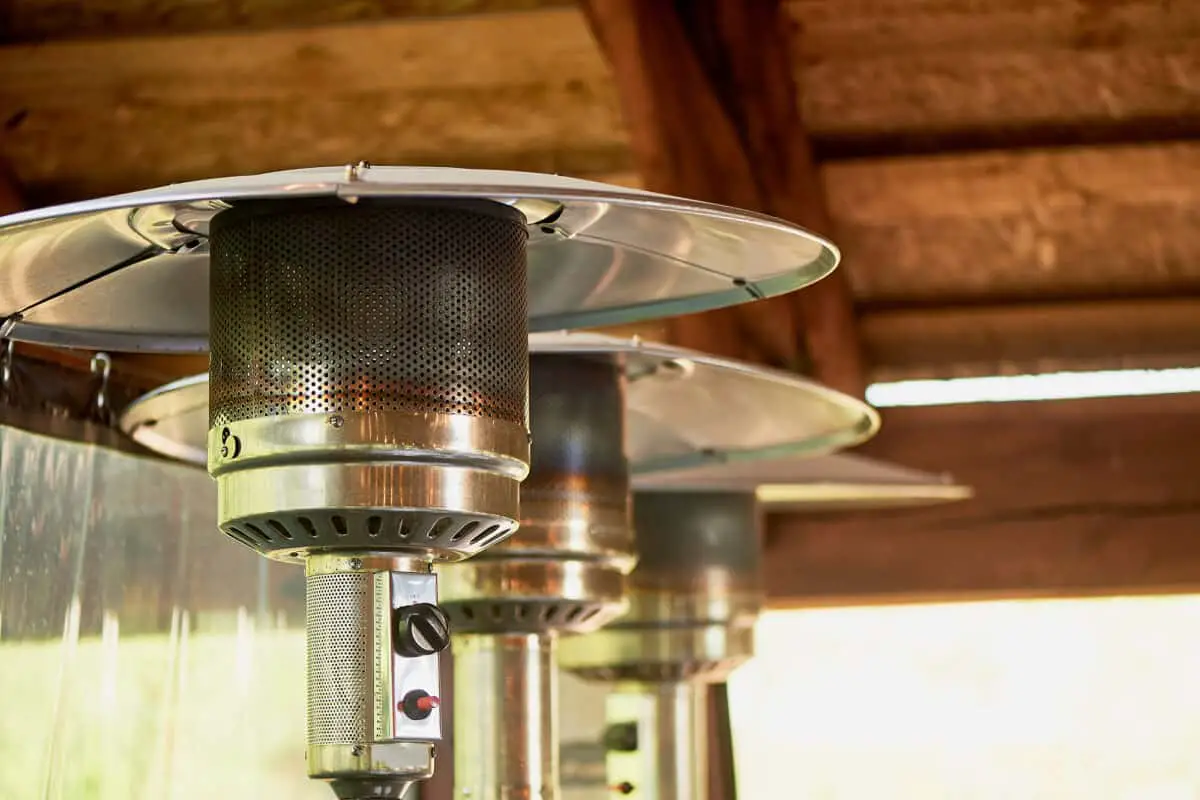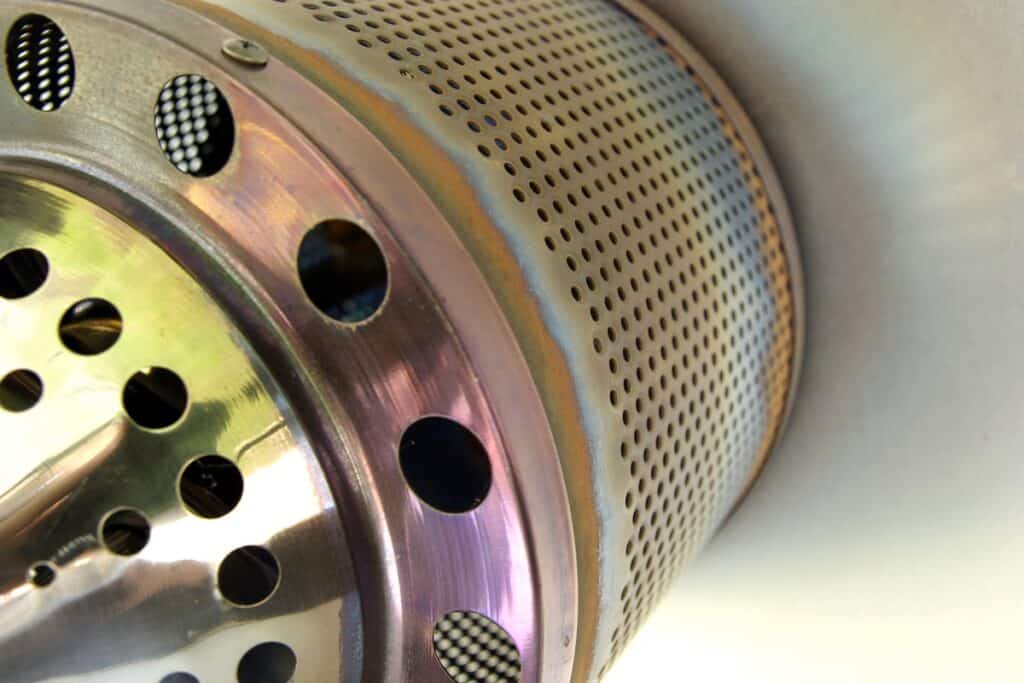You can prevent your patio heater from tipping over using weights, affixing to the ground, proper positioning, and other tips to make it more secure.
Patio heaters are a great way to keep your backyard cozy well into the wee hours of the morning. Unfortunately, the top-heavy design can sometimes make them a hazard for a patio heater tipping, especially if they aren’t adequately secured.
If your patio heater tips over, not only can it damage the unit and/or your patio, but it can also lead to severe consequences for your home, sparking a fire that could cause untold damage.
There are a few proactive steps that you can take to prevent your patio heater from tipping over, helping you protect against the unexpected.

Table of Contents
Prevent Your Patio Heater from Tipping
The best thing you can do to prevent your patio heater from tipping over is to ensure you secure it before use.
This will add stability to guard against people bumping into it, strong winds, inclement weather, animals knocking it over, and other accidents that can lead to your patio heater tipping over.
For the best results, consider securing your patio heater in one of three main ways:
- Add weight to the base of your patio heater
- Secure your patio heater to a fire-resistant, stable structure
- Affix your patio heater permanently to the ground
You can secure your patio heater in any number of ways, not just those listed above; however, you will want to make sure that you do so in a way that is safe and which does not present a fire hazard.
Let’s look at adequately securing your patio heater to prevent it from tipping over using the three methods above.
Add Weight to your Patio Heater’s Base
Each patio heater is designed differently, so you will want to be careful how you add weight to be sure not to destabilize it more accidentally.
If your patio heater has a reservoir at its base, you can use this to add weight and balance to your patio heater. People often fill the reservoir with either water or sand, but if you choose other materials, make sure they are fire-resistant.
Sand, while adding a small cost to the project, is often the most secure as you do not need to worry about refilling it.
Sand is a set-it-and-forget-it solution. Simply fill the reservoir with sand or sandbags and test the stability.
It should be heavy enough that the patio heater will not tip over even if you apply some pressure to one side.
If it is not, add more sand. Just make sure you don’t add so much that it spills outside of the patio heater.
If you use water, you must check on it every few weeks to refill the reservoir, as the water will evaporate over time.
This means there may be times when your patio heater is unsecured based on the volume of water.
Depending on the unit, you can add water directly to the base of the patio or you may need to use fire-resistant water carriers.
If you have questions about weighing down your particular patio heater, you can check the owner’s manual.
The manual will provide any instructions or requirements on how best to weigh down the reservoir in your patio heater, as well as what you should avoid to prevent accidentally damaging your unit.
If you do not have a reservoir, you can still add weight to the bottom of the heater, but it will be less aesthetically pleasing.
You can use sandbags, water weights, and any other fire-resistant objects outside the patio heater to add weight to the bottom of your heater.
This will serve the same purpose as adding weight internally in the unit, enhancing the balance and stability and preventing the patio heater from tipping over.
Because these weights are on the outside, you do run the risk of accidentally knocking them off or damaging them.
If you do not take notice of any shifting in the weights, this could cause your patio heater to be unbalanced.
You should make it a habit to check the weights periodically, reducing the patio heater from tipping vulnerability.

Secure Patio Heater to a Fire-Resistant Structure
Instead of adding weight, as previously mentioned, to prevent the patio heater from tipping over, you can secure it to a stable structure.
The structure can be either permanent or just heavy enough to provide stability for the heater.
These structures could be pillars, stone adornments, or anything heavy enough to secure it, preventing the patio heater from tipping over.
Keep in mind that everything that you use to secure your patio heater needs to be fire-resistant, including the materials you use to ensure the unit.
Stainless steel or other metal zip ties are good options. Avoid rope, plastic, and other materials that will melt or burn at low temperatures.
Additionally, if the structure is painted, ensure they are not oil-based paints.
Paint should be flame retardant, so it is best to avoid painted surfaces if possible. Stone, brick, and concrete will work best.
Affix Patio Heater to the Ground
One of the most effective ways to secure your patio heater is to affix it to the ground permanently.
You can do this using bolts and other permanent fixtures.
Be sure to read your owner’s guide to ensure nothing is preventing you from securing your patio heater this way.
You certainly want to avoid damaging any critical parts that could make your patio heater malfunction.
You will need to put some thought into a permanent location for your patio heater to be secured.
Before you do this, you will need to make sure the heater is on stable ground, like concrete or brick.
Avoid placing your patio heater in grass or dirt.
Not only could this accidentally light on fire, but it can also be easier for the patio heater from tipping over as this ground is less sturdy.
Bolting your heater to the ground will help anchor it to prevent it from tipping over.
This is a more permanent solution than the other two. Make sure you are comfortable with the placement keeping in mind pathways and further movement of people in the area.
Turn on the Anti-Tilt Feature
In addition to choosing one of the aforementioned methods of securing your patio heater, you may also want to consider turning on your heater’s anti-tilt feature.
Many patio heaters have a built-in anti-tilt feature.
This will not increase the stability of your patio heater but will help activate safety features should the patio heater tip over occurs.
The anti-tilt switch will automatically turn off your patio heater if it detects a falling motion.
This will shut off the gas flow, preventing a leak that could be extremely dangerous for you, your family, and your neighbors.
Be sure to test your anti-tilting switch periodically to ensure it is functioning properly. This will help ensure it will work in the case of an emergency.
Do not assume testing the anti-tilting switch requires tilting over the heating unit.
This can cause damage to the unit, including an accidental gas leak, which is the exact thing you are trying to avoid!
Consult your owner’s guide for instructions on how you can test your anti-tilting switch manually. Each unit has different instructions on how best to do this.
Position Your Patio Heater Properly
Even if you have weighed it down, you still want to consider its placement to prevent the patio heater from tipping over.
Even the most balanced patio heaters will tip over if not set up on the proper surface.
Here are a few things to keep in mind.
- Set up your patio heater on firm, even ground. This could be on a deck, patio, cement, sidewalk, etc. Just ensure it is out of the way so people will not trip over it or accidentally knock it over.
- You should never set up your patio heater on grass, mulch, or other unstable and flammable surfaces.
- Keep the heater away from any low-hanging branches, overhangs, and any other debris that could touch your patio heater and knock it over.
- Remember, the center of gravity for your patio heater is high. It is easy to fall when contact is made from the top.
- Keep your patio heater in a well-ventilated area, away from doors and windows. You don’t want to accidentally breathe in any of the gases while indoors.
- Low-traffic areas are ideal locations to set up, preventing the patio heater from tipping over accidentally by someone walking by.
Accidents happen, and the better you can set yourself up for success and avoid human error, the better!
Check the Weather
It is unsafe to operate your patio heater under certain weather conditions, especially when it is windy.
As a rule, you must avoid using your patio heater if the winds are over 10 miles (16 kilometers) per hour.
If you do use it during high wind conditions, there is an increased risk of the patio heater tipping over, no matter how well-weighted it is.
High winds can also blow the flame out, rendering it useless until you can catch the pilot light again.
When your patio heater is not in use, cover it.
This will prevent anything from getting caught in it and animals from taking refuge inside.
It is vital to cover the patio heater if it is windy, raining, or snowing.
Repeated exposure to harsh elements could shorten the lifespan of your patio heater.
Final Thoughts
Having your patio heater safe and secure before using it make for an enjoyable outdoor experience. You will continue to enjoy a cozy outdoor space for years to come.
The added time securing the heater is well worth it to avoid any potential patio heater from tipping accidents and fire risks.
Always make sure you are using your patio heater on a flat, non-flammable surface away from any low-hanging branches.
Remember never to use your patio heater in high winds.
Enjoy living the outdoor life!

